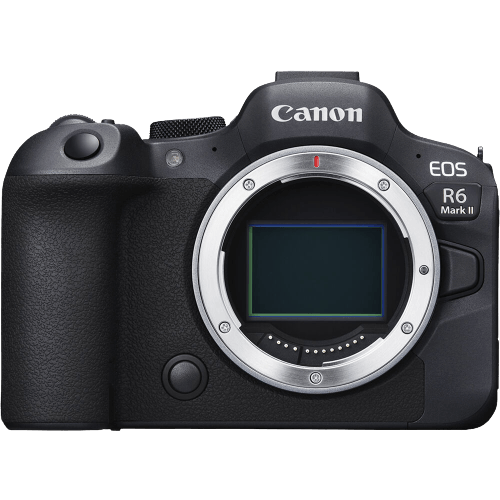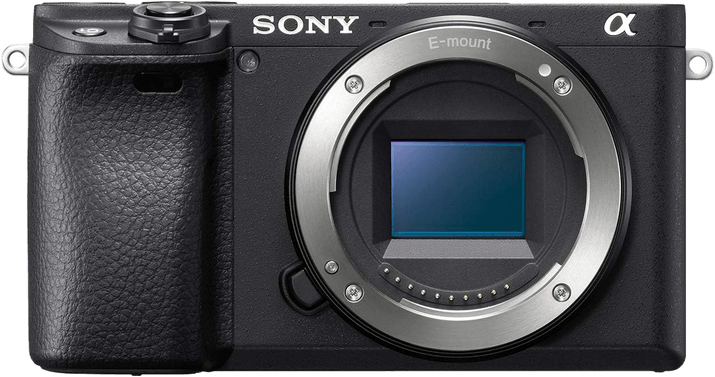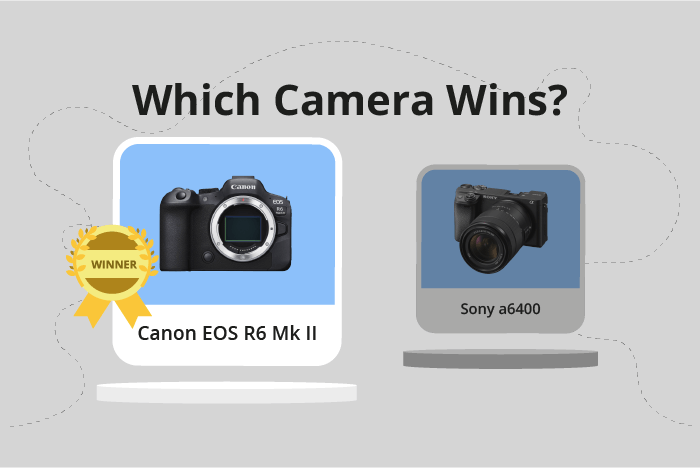Canon EOS R6 Mark II vs Sony a6400 Comparison
Canon EOS R6 Mark II

Sony a6400

The Canon EOS R6 Mark II outperforms the Sony a6400 with a score of 78/100 compared to the latter’s 70/100. Both cameras are mirrorless, released in 2022 and 2019 respectively. They share common specifications, but the Canon EOS R6 Mark II excels in certain areas.
The Canon EOS R6 Mark II has a larger size (138.4 �� 98.4 �� 88.4mm) and is heavier (588g), which might offer better ergonomics and stability. However, the Sony a6400 is more compact (120 x 67 x 60mm) and lighter (403g), making it easier to carry around.
Despite its higher launch price of $2499, the Canon EOS R6 Mark II justifies the cost with its superior performance. On the other hand, the Sony a6400 offers a more affordable option at $900 without compromising too much on quality.
Taking all aspects into account, the Canon EOS R6 Mark II proves to be a better camera, while the Sony a6400 remains a solid choice for those on a budget.
Canon EOS R6 Mark II vs Sony a6400 Overview and Optics
The Canon EOS R6 Mark II outperforms the Sony a6400 in optics, with a score of 83/100 versus 68/100. Both cameras share common specifications, such as 24 megapixels, CMOS sensor type, and compatible lens mounts (Canon RF for EOS R6 Mark II and Sony E for a6400).
The Canon EOS R6 Mark II excels in several areas. Its full-frame sensor size provides superior image quality compared to the Sony a6400’s APS-C sensor. The EOS R6 Mark II also boasts a higher DXOMARK score of 91, indicating better overall sensor performance. The camera’s shooting speed of 40 is significantly faster than the a6400’s 11, allowing for quicker capture of action shots. Additionally, the EOS R6 Mark II features image stabilization, which the a6400 lacks, leading to steadier and sharper images.
The Sony a6400, while lagging behind the EOS R6 Mark II, has a slight advantage in megapixels at 24.2. However, this minor difference does not significantly impact image quality. The a6400’s Bionz X processor is inferior to the EOS R6 Mark II’s Digic X processor, contributing to the lower overall score.
Comparing the two cameras, the Canon EOS R6 Mark II is the clear winner in terms of optics, due to its full-frame sensor, faster shooting speed, and image stabilization capabilities. The Sony a6400, though slightly higher in megapixels, falls short in other critical areas, making it less desirable for those prioritizing superior optics.
Canon EOS R6 Mark II vs Sony a6400 Video Performance
The Sony a6400 wins in the video capabilities comparison, scoring 91/100, while the Canon EOS R6 Mark II scores 83/100. Both cameras share common video specifications, including 4K max video resolution, 3840 x 2160 max video dimensions, and built-in time-lapse functionality.
The Sony a6400 outperforms the Canon EOS R6 Mark II in video frame rate, offering a maximum of 120fps compared to the Canon’s 60fps. This higher frame rate allows the Sony a6400 to capture smoother slow-motion footage, providing more creative flexibility for videographers.
Despite the lower score, the Canon EOS R6 Mark II still has great video capabilities. It matches the Sony a6400 in max video resolution, dimensions, and time-lapse functionality. However, the Sony a6400’s higher score is due to its superior video frame rate, which makes it a better option for those prioritizing video performance.
While the Canon EOS R6 Mark II falls short in video frame rate, it remains a solid choice for videographers looking for a camera with strong video capabilities. The Sony a6400, on the other hand, excels in this area, making it the ideal choice for those who need a higher frame rate for their projects. Both cameras offer impressive video features, but the Sony a6400’s higher score and frame rate make it the clear winner in this comparison.
Canon EOS R6 Mark II vs Sony a6400 Features and Benefits
The Sony a6400 emerges as the winner with a feature score of 81/100, while the Canon EOS R6 Mark II scores 72/100. Both cameras share several specs, including a 3-inch screen size, touchscreen capability, flip screen, WIFI, and Bluetooth connectivity.
The Sony a6400 surpasses the Canon EOS R6 Mark II in terms of features. Despite having the same screen size, the a6400 boasts a higher screen resolution of 921,600 dots, compared to the R6 Mark II’s 1,620,000 dots. This results in a crisper and clearer display for the a6400, allowing for better image preview and menu navigation. Additionally, the a6400 has a higher overall feature score, indicating that it offers more advanced and versatile capabilities.
On the other hand, the Canon EOS R6 Mark II has one advantage over the Sony a6400: GPS functionality. This feature allows the R6 Mark II to geotag photos, which can be useful for photographers who travel or need to keep track of locations for their work. However, this single advantage does not outweigh the overall better performance and features of the Sony a6400.
Given these points, the Sony a6400 proves to be the superior camera in terms of features, offering a higher resolution display and a more advanced set of capabilities. Although the Canon EOS R6 Mark II has the added benefit of GPS functionality, it falls short in comparison to the a6400’s impressive features.
Canon EOS R6 Mark II vs Sony a6400 Storage and Battery
The Canon EOS R6 Mark II wins the storage and battery comparison with a score of 68/100, while the Sony a6400 scores 31 points lower at 37/100. Both cameras share the same memory card compatibility, accepting SD/SDHC/SDXC cards and offering USB charging. However, the R6 Mark II has two memory card slots and supports faster UHS-II cards, giving it an advantage in storage capacity and speed.
The Sony a6400, on the other hand, has a longer battery life, providing 410 shots compared to the R6 Mark II’s 360 shots. Despite this advantage, it only has one memory card slot and supports the slower UHS-I cards. The Canon EOS R6 Mark II’s dual slots and faster card compatibility make it the superior choice for storage and battery performance.
Canon EOS R6 Mark II vs Sony a6400 – Our Verdict
Are you still undecided about which camera is right for you? Have a look at these popular comparisons that feature the Canon EOS R6 Mark II or the Sony a6400:

